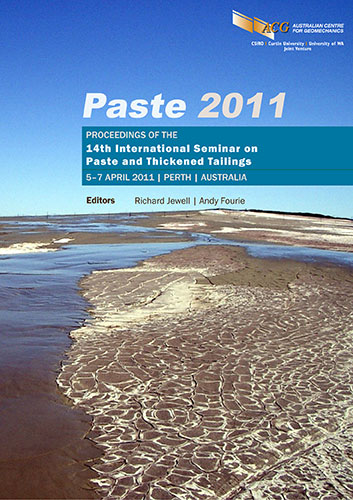Challenges in the design of pilot tests

|
Authors: Barrera, S; Becerra, M; Chacón, P; Quelopana, H |
DOI https://doi.org/10.36487/ACG_rep/1104_09_Barrera
Cite As:
Barrera, S, Becerra, M, Chacón, P & Quelopana, H 2011, 'Challenges in the design of pilot tests', in R Jewell & AB Fourie (eds), Paste 2011: Proceedings of the 14th International Seminar on Paste and Thickened Tailings, Australian Centre for Geomechanics, Perth, pp. 93-100, https://doi.org/10.36487/ACG_rep/1104_09_Barrera
Abstract:
The behaviour of tailings slurries, particularly at high concentrations, presents a significant number of uncertainties. To address this issue, it is common practice to perform pilot tests to verify or anticipate the expected tailings behaviour at large scale. In the last year three pilot tests were conducted on different kinds of tailings and conditions. The scaling and implementation of these tests present challenges derived mainly from the nature of a material formed by two phases and its tendency for sedimentation, the viscous behaviour of the fluid, the presence and variation in time of chemical additives, representativeness of tested material, differences in consultants/owners conceptual approach, etc. The pilot tests need to be designed in such a way that allows us to obtain key information and extrapolate this information to our real case. To achieve this, it is at least necessary to address the following types of definitions: (i) parameters to be analysed; (ii) conceptual model; (iii) tests specifications; (iv) model scale; (v) type of material and concentration levels to be tested; (vi) type and amount of material; and (vii) available equipment; among others. This paper describes the process in the design and start-up of a pilot plant oriented at studying the behaviour of a slimes slurry, highlighting the difficulties encountered and the ways of addressing and overcoming them. This paper does not analyse the test results, analysis which will be part of another document.
References:
Calle, F., González, A., Fernández, L. and Fuentes, R. (2009) Diseño de Sistemas de Transporte de Fluidos Bingham d Escala Industrial. Problemas de Scaling Up, XIX Congreso Chileno de Hidráulica, Sociedad Chilena de Ingeniería Hidráulica, Chile.
McPhail, G. (2008) Prediction of the Beach Profile of High Density Thickened Tailings from Rheological and Small Scale Trial Deposition Data, in Proceedings 11th International Seminar on Paste and Thickened Tailings (Paste08), A.B. Fourie, R.J. Jewell, P. Slatter and A. Paterson (eds), 5–9 May 2008, Kasane, Botswana, Australian Centre for Geomechanics, Perth, pp. 179–188.
Slottee, S., Johnson, J. and Crozier, M. (2005) Paste Thickening Iron Ore Tailings, XXXV Ironmaking and Raw Materials Seminar, VI Brazilian Symposium on Iron Ore, Florianópolis, Santa Catarina, Brazil.
Yuan, X.S. and Lahaie, R. (2009) Thickened tailings (paste) technology and its applicability in oil sand tailings management, in Proceedings Thirteenth International Conference on Tailings and Mine Waste (Tailings and Mine Waste ‘09), Banff, Alberta, Canada, D. Sego, M. Alostaz, N. Beier (eds), University of Alberta Geotechnical Center, 1–4 November 2009, Edmonton, Alberta, pp. 829-1–829-16.
© Copyright 2024, Australian Centre for Geomechanics (ACG), The University of Western Australia. All rights reserved.
View copyright/legal information
Please direct any queries or error reports to repository-acg@uwa.edu.au
View copyright/legal information
Please direct any queries or error reports to repository-acg@uwa.edu.au